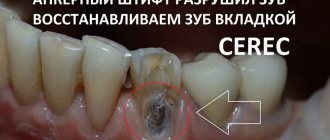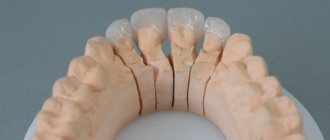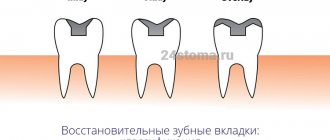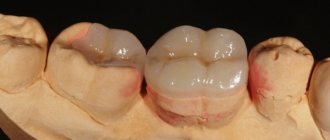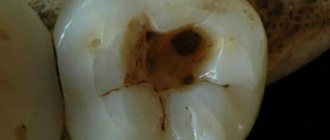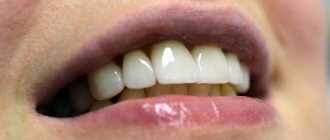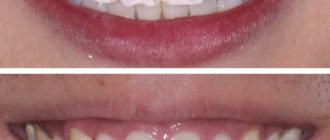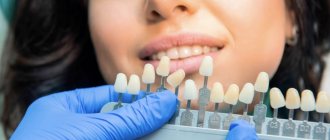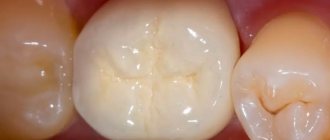Artistic or aesthetic restoration is a set of procedures to improve the appearance of teeth. With their help, you can hide complex and visible defects in enamel and return it to its original appearance. Dentists use artificial materials whose composition is similar to natural teeth. Therefore, artistic restoration allows you to achieve the optimal color combination of the filling and the remaining teeth. You can easily regain your lost beautiful smile in one or several visits to the doctor.
Dental restoration – what is it anyway?
Artistic dental restoration allows you to restore the shape and basic functions of damaged teeth using filling materials. With the help of the dentist’s skill, it is possible to restore the natural whiteness of the smile, eliminate existing defects in the dentition and achieve high aesthetics of the teeth.
Artistic dental restoration is a unique technique for restoring minor defects in the crown of teeth, making them more aesthetically pleasing and making your smile as attractive as possible. For this purpose, modern dental materials are used that imitate dental tissues and give the teeth the desired external characteristics.
Contraindications
Aesthetic dental restoration is not only an excellent result and an excellent alternative to prosthetics, but also a restoration technique that is not suitable for everyone. Like most other dental procedures, restoration has absolute and relative contraindications.
Absolute contraindications include the following:
- The patient has a pacemaker installed
. The use of a device such as a photopolymerizer for composite restoration can cause a disturbance in the pulse frequency of the pacemaker. This is a huge risk to the health and life of the patient, as it can lead to cardiac arrest. - Allergy to composite materials
. It is extremely rare, but if the patient has an allergic reaction to adhesive systems or photopolymer materials, then it is worth choosing other methods of solving aesthetic problems rather than restoration. - Inability to isolate the tooth from moisture
. Some patients experience a psychosomatic reaction that does not allow the installation of a dental dam in the oral cavity. In these cases, restoration with composite materials with a quality guarantee is simply impossible.
So far, no other absolute contraindications to restoration have been found. This means that if you do not have the listed points, it is worth studying the relative contraindications in order to understand whether this recovery method is suitable for you or not.
Relative contraindications include:
- Teeth wear due to incorrect (straight) bite
. In this case, restoration should be postponed until the occlusion correction is completed. - Bruxism
. Strong compression of the jaws can cause premature destruction of the composite materials used in restoration. Therefore, in case of involuntary teeth grinding, it is recommended to use not restoration, but more reliable restoration methods, for example, installing crowns or other orthopedic structures. - No chewing teeth
. If they are absent in the lateral parts of the oral cavity, restoration of the anterior teeth is contraindicated. The fact is that in this case, the entire chewing load will be redistributed to the front teeth, which will lead to premature wear and destruction of the restored parts. - Significant destruction of hard tissue
. If, at the time of contacting the dentist, the tooth is destroyed by a third or more, the restoration cannot guarantee the reliability of the structure. In this case, it is worth using alternative methods to solve the problem.
In addition, restoration by direct and indirect methods is contraindicated for those patients who do not observe regular and mandatory oral hygiene. For such people, it is better to get metal or ceramic crowns rather than using composite fillings.
Prices for dental restoration in Moscow
Artistic restoration of teeth in Moscow is carried out in Vimontale. The method of tooth restoration is selected individually. When choosing the most suitable method, several factors are taken into account: the patient’s age, the nature of the enamel damage, general health, and the condition of the pulp. We offer the most affordable prices for dental restoration.
Aesthetic dentistry Price
Consultation with an orthopedic dentist, drawing up an orthopedic treatment plan 0 rub.
Anesthesia - application 100 rub.
Anesthesia - infiltration 400 rub.
Ceramic veneer E-MAX Up to 5 teeth 20,000 Promotion
Ceramic veneer E-MAX Over 8 teeth - 25% discount 15,000 20,000 rubles
Ceramic veneer E-MAX From 6 to 8 teeth - 15% discount 17,000 20,000 rubles
Aesthetic restoration 3,000 rub.
Production of a diagnostic model RUB 1,000.
Diagnostic model made of plaster 490 rub.
Diagnostic model made of class III-IV supergypsum 690 rub.
Polishing 1 tooth 90 rub.
In what cases is the dental restoration procedure used?
The procedure allows you to solve the following problems:
- carious damage to most of the frontal tooth surface;
- gaps between teeth;
- chips and damage to enamel;
- more than 50% destroyed crown;
- changes in enamel shade.
Aesthetic restoration provides an opportunity to correct the shape and color of teeth. After the procedure, they look natural and match the appearance and function of healthy teeth.
The cost of such a procedure depends on the nature of the defect and the methods used to eliminate it. This issue can be discussed at a clinic appointment.
Read also
Why do teeth crumble?
Tooth decay in general, and crumbling in particular, is not an aesthetic problem.
How to restore and strengthen tooth enamel
Enamel is the outer shell of the tooth, which bears the heaviest load (chewing). She is the first to take on the “blows” of active substances contained in food and drinks.
Methods of aesthetic dental restoration
Methods for correcting imperfections in the shape, color and arrangement of elements of the dentition are usually divided into direct and indirect. In the first case, we are talking about a one-time visit to the dentist to restore aesthetics through the use of filling materials. Using photopolymers and composites, you can correct chips, cracks, scratches in enamel, discoloration, and also restore damaged crowns.
Indirect dental restoration involves correction using structures individually manufactured in the laboratory - crowns, veneers, inlays. This will require several visits to the dentist for preparation, taking an impression and fixing the finished structure.
Crowns are used if the tooth is destroyed by more than 50%. They use structures made of metal-ceramics and ceramics. They look natural, are durable and last 10–20 years.
Veneers are thin plates (0.5–0.7 mm) that make it possible to hide such defects: small gaps between the teeth of the frontal group, chips of the cutting part, discoloration of the enamel, unsightly shape of the dental unit. The designs are resistant to food coloring and retain their shine.
Dental restoration with inlays is applicable for significantly damaged teeth in the lateral chewing group. Microprostheses are made according to the shape of the defect and ideally restore the coronal part. The material is ceramics, whose properties and appearance are similar to natural dental tissues.
In Moscow, you can take advantage of direct and indirect dental restoration at the Vimontale clinic. We use advanced technologies and materials to restore the beauty and natural appearance of teeth. Sign up for a free consultation to find out which method of front teeth restoration is right for you and what the cost of the entire range of work is.
Our patients save money through promotions and discounts (check the website). We also cooperate with insurance companies.
The clinic's specialists make sure that your smile is beautiful and healthy!
Indications for the procedure
The main indications for restoration include the following:
- Correction of aesthetic defects. It is an improvement in the appearance of teeth damaged by caries or having defects in hard tissues. As part of this, dentists offer: Correction of enamel color. Moreover, restoration allows you to even out the color of not only a living tooth (using veneers on the vestibular surface), but also a dead tooth (using an indirect restoration method with the production of composite veneers or crowns).
- Correction of tooth shape and size. The main advantage of modern dentistry in solving this problem is the ability to obtain results in one visit to the clinic, especially if the issue concerns a minor diastema or other purely aesthetic defects. If the case is complex or advanced, experts offer alternative correction methods, for example, using inlays or crowns.
- Correction of the position of the tooth(s) in the row. The use of composite materials can provide immediate results when a single “movement” of individual teeth is required. If the problem is not purely aesthetic, then planned orthodontic treatment will be required.
In general, aesthetic restoration of teeth is an opportunity to correct minor cracks and chips, even out unsatisfactory enamel color, correct slight curvatures of the dentition (arising, for example, as a result of periodontitis), and get rid of the consequences of interdental, cervical and deep caries.
Dental restoration methods: direct and indirect
Artistic restoration can be direct, in which the main manipulations are performed in the oral cavity, and indirect, when replacing structural defects are made in a dental laboratory and taking into account individual measurements and parameters. The specific option is selected by the patient with the help of the dentist. Indirect restoration is more aesthetically pleasing and durable, but is more expensive.
Direct restoration of teeth with composite material (filling)
The direct method of artistic restoration is carried out using high-quality composites that are resistant to stress, adverse thermal and chemical influences, and pathogenic microorganisms. The procedure is carried out in several stages.
Artistic restoration can restore the aesthetics of teeth that were previously depulped. To increase the reliability of restoration materials, a pin is installed in the root canal. This makes it possible to strengthen the composite material used and increase the service life of the restoration.
During dental restoration using composites, teeth are reliably isolated from high humidity and contact with the patient’s saliva using latex materials that have appropriate holes for the teeth. If the doctor does not pay due attention to this issue, then the service life of the filling material is sharply reduced and due to the loose fit of the filling to the tooth, caries may occur.
The dentist applies filling materials in layers that match the tone of the patient’s teeth. During this, a composite of different shades and degrees of transparency is used, thanks to which it is possible to obtain the most natural shade of tooth enamel. The final stage is the final correction of the shape of the teeth, grinding of excess areas and visible irregularities. The restoration becomes indistinguishable from natural tooth enamel.
Direct aesthetic restoration of teeth - advantages and disadvantages
The main advantage of direct restoration is the speed of correction of existing enamel defects. The procedure takes no more than 30-60 minutes and is completed in one visit to the dentist. The disadvantages include the relatively short period of time for preserving the aesthetics of the restoration: after 1.5-2 years, composite materials begin to turn yellow, as they absorb dyes coming from food and drinks.
Indirect restoration
Indirect artistic restoration involves the use of dental inlays and ceramic veneers. Modern ceramics can withstand intense chewing loads and at the same time look as natural as possible. With the help of such restorations, you can easily recreate the volume of damaged enamel and make unevenness and chips on the crown of your teeth invisible.
Artistic restoration is always recommended to be carried out after professional teeth cleaning, whitening and plaque removal. These preparatory measures help to slightly whiten the enamel and eliminate colonies of microbes that can provoke the development of infectious complications after restoration. Using a special scale, the dentist selects the most suitable color of materials that will be used to correct enamel defects.
Subsequently, the carious cavities are excised. If necessary, local anesthesia can be used. Old fillings that have lost their aesthetic appearance must be replaced. Restorative structures are made from individual impressions in a dental laboratory.
Veneers
Veneers are thin microprostheses. They are used in dental restoration to create an ideal smile. The plates are most often made from ceramics. Before installing them, it is necessary to grind down the tooth enamel a little. But composite veneers made from high-quality light-polymer materials are also in demand.
Aesthetic dental restoration with veneers - advantages and disadvantages
Properly carried out artistic restoration of teeth can eliminate all existing dental defects:
- change the tone of tooth enamel;
- correct the shape of the teeth and their position in the dentition;
- eliminate excessive gaps between teeth;
- restore the aesthetics of your smile.
Artistic restoration with veneers does not require pulp removal or significant grinding of enamel and is considered a fairly comfortable procedure. With its help, it is possible to keep teeth alive, as close to natural as possible.
The disadvantages include the relatively high cost of ceramic veneers. But the price corresponds to the materials used, technologies and the final result.
Main stages of treatment
- Diagnostics
– medical consultation and examination, professional hygiene (removal of plaque, tartar), selection of material using a color scale. - Preparation
– elimination of detected dental problems (removal of old fillings, treatment of caries), preparation of enamel. - Restoration
- isolation of an incisor or molar from saliva (installation of a rubber dam), degreasing the surface with a special composition, restoring the shape by layer-by-layer application of plastic composites, taking into account the dental grooves and features of the cutting edge. (In case of significant damage to the coronal part, a pin or dental inlay is additionally installed). - Polishing
– final modeling of the shape, grinding, polishing the surface to give a natural shine and smoothness.
Aesthetic dental restoration
is an effective, painless procedure. Restoring 1 tooth takes 40-60 minutes. Several units can be restored in one visit.
Restoration of chewing teeth
To restore chewing teeth, recreate their shape and the strength of hard tissues, composite materials and special inlays are used that replace the missing parts of the enamel.
Expert of the article you are reading:
Bystrov Alexey Albertovich
Dentist orthodontist, general dentist
You may also be interested in:
Ceramic veneers Lumineers price for 1 tooth in Moscow Ceramic veneers E-max
Show more
Our patients
Patient recommendations
Akhmedkhanov Said Rashidovich
Dental surgeon, general dentist, implantologist, orthopedic dentist, dental therapist.
Make an appointment 8 (499) 520-98-70
Make an appointment
Recommendations from patient Alekseeva O.V.
Akhmedkhanov Said Rashidovich
Dental surgeon, general dentist, implantologist, orthopedic dentist, dental therapist.
Make an appointment 8 (499) 520-98-70
Make an appointment
Recommendations from patient Zolotareva S.V.
Akhmedkhanov Said Rashidovich
Dental surgeon, general dentist, implantologist, orthopedic dentist, dental therapist.
Make an appointment 8 (499) 520-98-70
Make an appointment
Recommendations from patient Vera
Akhmedkhanov Said Rashidovich
Dental surgeon, general dentist, implantologist, orthopedic dentist, dental therapist.
Make an appointment 8 (499) 520-98-70
Make an appointment
Recommendations from patient Mikhail Ivanovich
Akhmedkhanov Said Rashidovich
Dental surgeon, general dentist, implantologist, orthopedic dentist, dental therapist.
Make an appointment 8 (499) 520-98-70
Make an appointment
Collapse
